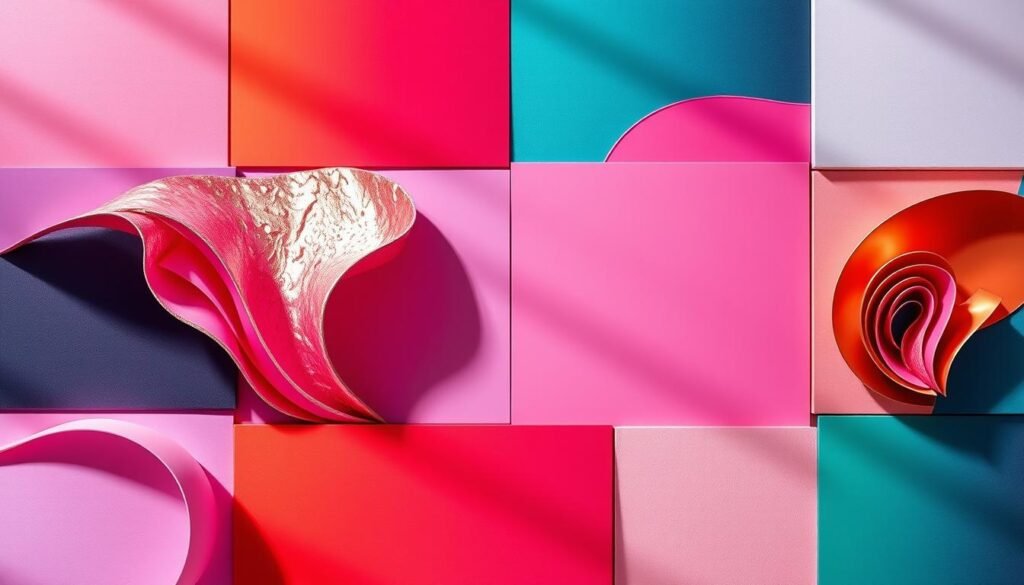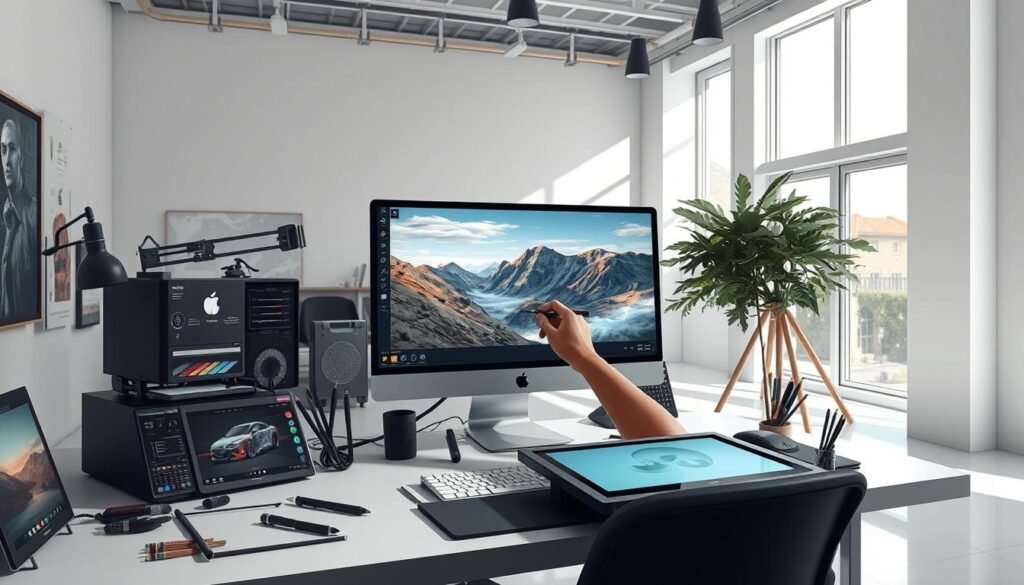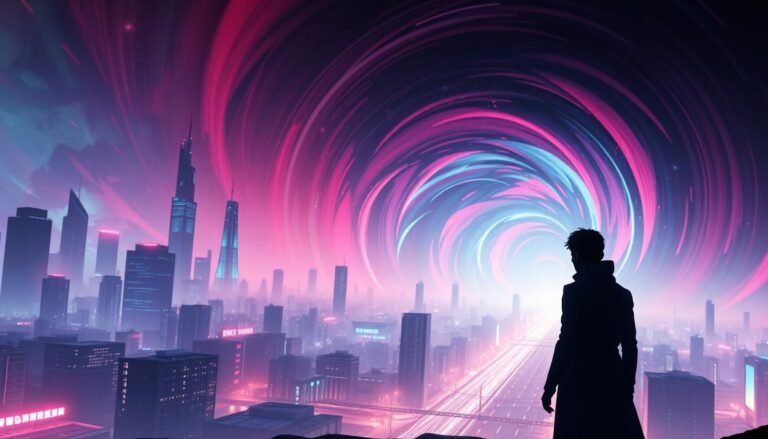Imagine holding an album cover that tells a story and evokes emotions. It leaves a lasting impression. For musicians and artists, creating such a cover is key to their brand.
In music, concept art shapes the album’s visual story. AI tools like MidJourney let artists explore new ways to create. They can bring their visions to life through prompt engineering.
The mix of art and technology opens new ways for musicians to create stunning visuals. These visuals captivate their audience.
Key Takeaways
- Discover how to craft compelling MidJourney prompts for award-worthy album covers.
- Learn the importance of concept art in music branding and visual identity.
- Explore the role of prompt engineering in creating unique album cover art.
- Understand how to leverage AI tools to enhance your creative process.
- Get insights into designing album covers that resonate with your audience.
Understanding Album Cover Aesthetics
Album covers are more than pretty pictures. They tell a story that listeners connect with. The look of an album cover is key to sharing the artist’s message and style. It’s a big part of music branding.
The Art of Visual Storytelling
Visual storytelling is central to great album covers. It uses images, colors, and fonts to capture the music’s essence. A well-made cover can stir emotions, spark interest, and leave a lasting mark on listeners.
Key Techniques in Visual Storytelling:
- Using metaphors and symbolism to add depth to the narrative
- Incorporating elements that reflect the artist’s personality and style
- Employing color palettes that resonate with the mood of the music
Key Elements of Effective Album Covers
Several elements make an album cover stand out. Knowing the artist’s brand, using top-notch images, and creating a design that looks good and means something are key.
| Element | Description | Example |
|---|---|---|
| Imagery | High-quality images that reflect the artist’s style and music genre | Surreal collage or vector retro elements |
| Color Palette | Colors that evoke the mood and atmosphere of the music | Bold colors for energetic music, muted tones for melancholic tracks |
| Typography | Fonts that are legible and align with the artist’s brand identity | Serif fonts for classical, sans-serif for modern electronic music |
By using these elements, artists and designers can make album covers that are stunning and tell a story. This story connects with listeners on a deep level.
What is MidJourney?
MidJourney is a digital art platform that uses AI to create amazing visuals from text. It’s changing how artists, designers, and musicians work on projects, like album covers.
Overview of MidJourney Features
MidJourney has many features that make it essential for artists. Some key ones are:
- Advanced AI algorithms that understand complex text prompts
- The ability to make high-resolution images with lots of detail
- A user-friendly interface that makes creating easier
- Flexibility in style and output, allowing for a wide range of artistic expressions
These features help artists explore new creative possibilities, expanding what’s possible in concept art and design.
How MidJourney Works for Artists
For artists, MidJourney is a powerful tool for bringing ideas to life through prompt engineering. By writing detailed text prompts, artists guide the AI to create artwork that matches their vision.
The process is:
- Defining the concept or theme of the artwork
- Crafting a detailed text prompt that captures the essence of the desired artwork
- Using MidJourney’s interface to input the prompt and generate the image
- Refining the output through iterative adjustments to the prompt or parameters
This workflow makes the creative process smoother and opens up new ways for artistic exploration and innovation, mainly in concept art.
Crafting Your First MidJourney Prompt
To get the most out of MidJourney, learning to craft effective prompts is key. A good prompt is more than just words. It’s a clear guide for the AI to create what you want.
Components of a Great Prompt
A top-notch MidJourney prompt has a few important parts. You need a clear subject description, the style you’re aiming for, and any special details you want. For example, if you’re making an album cover, you might ask for a grunge overlay to set the mood.
- Clear description of the subject
- Desired style or aesthetic
- Specific elements to include or avoid
Examples of Basic Prompts
Here are some basic prompts to show how these parts work together. For a grunge album cover, your prompt could be: “Create an album cover with a grunge overlay, featuring a dark, moody landscape with a hint of nostalgia.”
- “Design an album cover that incorporates a surrealist theme with vibrant colors.”
- “Create a minimalist album cover with a simple, yet striking typography.”
- “Produce an album cover that merges digital art with traditional photography, featuring a futuristic cityscape.”
By knowing what makes a great prompt and trying out different ones, you can get better at crafting midjourney prompts. This will help you create amazing album covers.
Inspired Themes for Album Covers
Album covers tell a story through visuals, from the surreal to the simple. They capture the music’s essence and create a lasting impression on listeners.
Fantasy Elements in Design
Fantasy elements make album covers stand out. Artists use mythical creatures, dreamlike landscapes, or abstract ideas to give their music a unique look. For example, a collage with dreamy images can spark curiosity and wonder.
Embracing Minimalism
Minimalism offers a clean, direct way to design album covers. Simple designs can send a strong message or mood with just a few elements. This style works well for music that values simplicity.
Incorporating Nature Imagery
Nature themes are also popular, with options from calm landscapes to natural patterns. Adding elements like leaves or water can make the cover feel organic. It connects the music to the natural world.
| Theme | Description | Example |
|---|---|---|
| Fantasy | Incorporates mythical or surreal elements | Surreal collage with dreamlike imagery |
| Minimalism | Simple, clean design with few elements | Simple typography on a plain background |
| Nature Imagery | Features elements from the natural world | Landscape photography with abstract patterns |
Genre-Specific MidJourney Prompts
Different music genres need unique visual styles. MidJourney prompts can help create these styles. This section will show how to make prompts for rock, pop, electronic, classical, and jazz music. This will make your album cover look great and boost your music branding.
Rock and Alternative
Rock and alternative music often has bold, edgy looks. Use prompts with “gritty,” “dark,” or “rebellious” to get this vibe. For example, “Create an album cover with a gritty, dystopian landscape and a bold, rock-inspired font.”
Think about adding images that show the genre’s energy. This could be concert crowds, guitars, or sound wave patterns. These images will connect with rock and alternative fans.
Pop and Electronic
Pop and electronic music has bright, futuristic looks. Use prompts with “neon,” “glowing,” or “minimalist” for this style. For instance, “Design an album cover featuring a minimalist, neon-lit cityscape at dusk.”
To make your design pop, add elements that show the genre’s lively vibe. This could be cool typography or geometric patterns.
Classical and Jazz Influences
Classical and jazz music is known for its elegance and sophistication. Use prompts with “elegant,” “ornate,” or “vintage” to capture this. For example, “Create an album cover with a vintage, ornate frame and a classical music-inspired motif.”
Adding images that show the genre’s history can make your design richer. This could be classical instruments or jazz club scenes.
By making your MidJourney prompts fit your music genre, you can create stunning album covers. These covers will also connect with your audience.
Color Theory and Mood
In album cover design, color theory is a key element that evokes emotions and moods. The right colors can change how people see an album. Design experts say, “Colors can evoke emotions, convey messages, and even influence moods.”
“Colors can evoke emotions, convey messages, and even influence moods.”
Color theory is very important in album covers. It can make or break the album’s look. The right colors can make the album more appealing to listeners.
Choosing Color Palettes that Resonate
Choosing colors that connect with the audience is key. For example, dark colors might fit a heavy metal album. But, pastel colors could be better for indie pop.
- Consider the genre of music and its associated colors.
- Think about the emotions and moods the album aims to evoke.
- Experiment with different color combinations to find the perfect palette.

How Colors Affect Perception
Colors can change how we see an album cover. Warm colors like red and orange can feel energetic. Cool colors like blue and green can feel calm.
The psychological impact of colors is important in design. Knowing how colors work can help artists show their music’s true spirit.
| Color | Emotion/Evoked Feeling |
|---|---|
| Red | Energy, Passion |
| Blue | Calmness, Serenity |
| Green | Nature, Harmony |
By picking colors that match the music’s mood, artists can make covers that look good and feel right.
Typography in Album Covers
In album cover design, typography is more than picking fonts. It’s about creating a visual story that matches the music. It’s key to showing the album’s mood, genre, and identity.
The right typography makes an album cover stand out. It’s about finding a balance between looks and readability. The fonts should be eye-catching yet easy to read.
Selecting Fonts that Fit Your Genre
Music genres have their own typographic styles. Rock albums might use bold fonts, while jazz uses elegant serif fonts. Choosing a font that fits the genre tells listeners what kind of music it is.
- Rock and metal use bold, distressed fonts.
- Pop and electronic use sleek sans-serif fonts.
- Classical and jazz use traditional serif fonts for sophistication.
Incorporating Text with Images
When adding text to album covers, it must be clear and not compete with the image. Balancing text and image is about color, size, and where it’s placed.
| Design Element | Considerations |
|---|---|
| Color | Contrast with the background, visibility |
| Size | Legibility, prominence |
| Placement | Visual balance, avoiding clutter |
Design expert notes, “Typography is the voice of the visual elements.” When done right, it boosts the album cover’s story. Good typography is not just about looks; it’s part of the album’s identity and marketing.
“The right typeface can make an album cover instantly recognizable, much like a logo.”
Incorporating Imagery and Symbols
Imagery and symbols are key in making album covers stand out. They make the covers not just pretty but also meaningful. Artists use them to share deep themes and feelings, connecting with fans on a deeper level.
Using Icons and Illustrations
Icons and illustrations are powerful in album cover design. They can show complex ideas in a clear and engaging way. For example, a stylized picture of a mythical creature can show the magical side of an artist’s music.
Key benefits of using icons and illustrations include:
- Enhanced visual appeal
- Ability to represent complex themes simply
- Flexibility in design styles
Merging Photography with Digital Art
Combining photography with digital art creates unique and eye-catching visuals. Techniques like surreal collage mix real images with fantasy, making album covers stand out.
Some techniques for merging photography with digital art include:
- Layering photographic images with digital illustrations
- Manipulating photographs to create surreal effects
- Combining different textures and patterns
The table below shows examples of imagery and symbols in album covers, along with what they mean:
| Imagery/Symbol | Interpretation | Example Album |
|---|---|---|
| Skull | Rebellion/Mortality | Rock albums |
| Lotus Flower | Spiritual Growth | Ambient/Healing albums |
| Broken Chains | Freedom/Empowerment | Pop/Empowerment anthems |
By carefully choosing imagery and symbols, artists can make album covers that are not just beautiful but also full of meaning and connection.
Enhancing Your MidJourney Output
Take your album cover designs to the next level by mastering MidJourney art. It’s important to know the tools and techniques available to you.
Utilizing Variations and Styles
MidJourney lets you create many versions of a design from one prompt. By using these variations, you can try out different ideas. Choose the one that matches your album’s style best.
- Try different styles by changing your prompt’s parameters.
- Apply unique effects with the stylize option.
- Discover vector retro styles for a unique look.

Post-Processing Tips for Finished Designs
After creating your album cover art, it’s time for post-processing. This step refines your design for digital and print use.
- Adjust the colors to match your brand and music style.
- Use image editing software for brightness, contrast, and saturation tweaks.
- Make sure the design is high-resolution for printing.
Follow these post-processing tips to improve your album cover’s quality. This will help it stand out in the music world.
Reviewing Inspirational Case Studies
Album covers from 2023 show us what’s new in music visuals. They show the artist’s vision and are key to their brand. This makes them very important for artists.
Successful Album Covers from 2023
2023 was a great year for album covers. Many designs caught the eye of fans and critics. For example, Billie Eilish’s cover had a striking minimalist design that people loved.
Kendrick Lamar’s cover was another hit. It used complex typography and images that matched the album’s themes. These designs show how good design can make an album stand out.
Analyzing Visual Trends in Music
Looking at 2023 album covers, we see some trends. There’s a big move towards bold color schemes and innovative typography. This shows a trend in music branding towards being creative and trying new things.
Many albums now use minimalist design elements. This means clean, simple visuals that let the music shine. This trend is big in electronic and pop music, where less is more.
Also, digital art and photography are getting better. This lets artists make unique and eye-catching covers. Mixing old and new media has opened up new ways for artists to express themselves.
Finalizing Your Album Cover Design
Creating your album cover is more than just being creative. It also needs a careful review and preparation phase. This step is key to making sure your artwork looks great and is ready for sharing.
Gathering Feedback from Peers
Getting feedback from others is a must before you finalize your album cover. It helps you see how others view your artwork. Constructive criticism can make your design even stronger.
Share your design with artists, designers, or music fans. You can use online forums, social media, or local design groups. Listen to their opinions and make changes based on their feedback.
Preparing Files for Printing and Digital Release
After you’re happy with your design, it’s time to get your files ready for printing and digital release. Make sure your files are in the right format and resolution. For printing, you’ll need a 300 DPI file. Digital releases might need different specs.
| File Specification | Printing | Digital Release |
|---|---|---|
| Resolution | 300 DPI | 72-300 DPI |
| File Format | TIFF or PSD | JPEG or PNG |
| Color Mode | CMYK | RGB |
For vinyl releases, make a vinyl mockup. It shows how your design will look on the vinyl. This helps spot any problems before you start making it.
By carefully finishing your album cover design and preparing your files right, you’ll have a professional and impactful release. It will surely connect with your audience.
Promoting Your Album Cover Creation
After making your album cover with MidJourney, it’s key to share it on social media. This will grab your audience’s attention and build fan interest.
Strategies for Effective Social Media Sharing
Post high-quality images on Instagram and Facebook to get more eyes on your work. Use the right hashtags to make it easier for people to find. Also, tag influencers or artists who might be interested.
Sharing concept art and design steps can really get fans excited. It shows them the effort you put into your work.
Engaging with Fans Through Visual Storytelling
Visual stories are great for sharing your album cover. Tell the story of your design and what inspired it. This connects fans to your music on a deeper level.
By using social media and concept art, you can build excitement for your album. You’ll also attract new fans to your music.


